The Americans with Disabilities Act (ADA) was passed in the early 90s as a way to accommodate disabled persons. The act consists of guidelines for everything from how much space there should be in a handicap bathroom stall to how high a light switch can be. ADA outdoor lighting requirements include guidelines on bus stop lighting and lights for visual alarms.
What Does ADA-Compliant Lighting Mean?
To be ADA-compliant, lighting must adhere to the guidelines set out in the ADA, aiming to make spaces more accessible to people with and without disabilities. With 26% of American adults living with a disability of some sort — approximately 14% with mobility issues, seven percent with a disability that prevents them from living independently and five percent with vision impairment — making sure public areas accommodate all individuals is crucial. Many might overlook or take for granted the role lighting plays in ADA compliance, but it’s one of the most important factors.
What many able-bodied people probably take for granted — such as turning off a lamp after reading, opening a door or even walking through a snowy park — can be a giant hurdle for individuals with disabilities. Many focus on the ADA guidelines for things like accessible toilets and ramps or elevators at entrances to shops and buildings, but the ADA goes into the minutia of accessibility as well, providing guidelines for things like the buttons on ATMs and how much space is necessary between furniture.
ADA lighting standards make it easier for people who are visually impaired to move around the world, but they also apply to individuals with mobility issues, including those who use wheelchairs or crutches. They take into consideration how much a fixture protrudes from a wall and how far off the ground each installment must be. These standards also tackle issues faced by people who have cognitive or dexterity issues or trouble with fine motor skills — regardless of whether their condition is temporary or permanent.
The definition of ADA-compliant lighting isn’t limited to adults with disabilities either. Things like light switches should be as accessible to children as adults — including children in wheelchairs. While the focus is on the safety and accessibility of individuals with disabilities, the goal is to make public spaces easy to access for everyone.
The ADA lighting requirements are just that: requirements. Businesses found to be in violation of these requirements can face fines as well as a loss of reputation. As of 2014, the amount for fines increased for both first and repeat offenses. A first violation can now be fined up to $75,000, while repeat violations can add up to $150,000.
ADA Requirements for Wall Sconces
The ADA requirements for wall sconces falls under section 204, “Protruding Objects.” This section refers to anything that may stick out from walls, doors or ceilings, which includes sconces as well as water fountains and payphones. It aims to protect people from potentially being injured, which, in turn, also protects businesses from the risk of lawsuits.
The ADA decided to create specific regulations around how far objects can protrude from walls or columns for specific reasons. For example, individuals with a visual impairment, especially those who use a cane, tend to travel close to walls, so ADA-compliant wall sconces need to protrude only so far so that they don’t interfere with anyone who walks by. Similarly, people in mobility devices need enough room to pass through hallways, aisles and passages without bumping into anything that protrudes from a wall or column.
ADA Sconce Depth
ADA sconce projection, or depth, means how much it’s allowed to stick out from a wall, partition or column. Up to 27 inches off the ground is considered the “cane sweep,” referring to the space needed for a person who is visually impaired to detect what’s ahead with their cane. Anything that protrudes in the cane sweep area has no limitations for how far it projects outward because the cane will collide with it to alert the person of the obstacle, and anyone without vision impairments should be able to clearly see it.
Similarly, any fixtures located in the topmost part of a room — which is 80 inches and above — have no restrictions since they are well above adequate headroom and pose no threat of injury.
However, most lighting sconces will not be fixed close to the ground or way above guests’ heads. Most likely, your lighting sconces will be between 27 and 80 inches above the finished floor. The fixtures protruding between 27 and 80 inches from the ground do have a restriction: they cannot protrude more than 4 inches from the wall, column or partition.
The ADA regulations regarding protruding objects apply to sconces in any location, including hallways and corridors as well as hotel rooms and lobbies. As mentioned, these regulations are in place to prevent the risk of injury that may result from guests bumping into protruding objects. Such injuries can be as mild as a bruise or as serious as a concussion, so it’s always better to be safe than sorry.
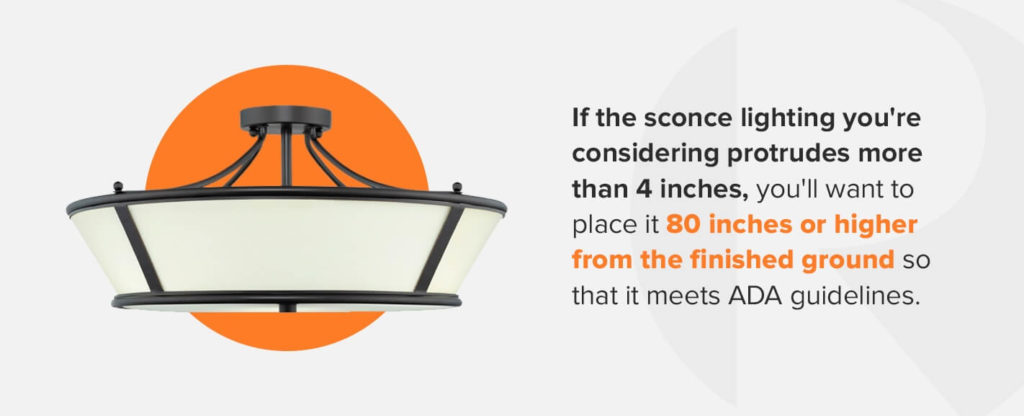
ADA Sconce Height
The maximum height of ADA-compliant wall sconces depends on whether they fall into or out of the cane sweep and headroom clearance areas. Technically, the sconce height can be as high or low as you want, but the extent of the sconce projection will differ based on where the sconce lighting is attached.
If the sconce lighting you’re considering protrudes more than 4 inches, you’ll want to place it 80 inches or higher from the finished ground so that it meets ADA guidelines by surpassing the minimum headroom clearance and not being in a space where someone could bump their head. Depending on the type of sconce lighting you’ve chosen and the industry of your business, the sconce can also be placed near the ground as long as it isn’t attached higher than 27 inches from the ground.
The ADA-compliant light switch height must also be adhered to no matter where it’s located. Light switches in kitchens, hotel rooms and bathroom must all be accessible to everyone, and the ADA requires switches to be located no higher than 48 inches above the ground with no obstructions and nothing in the way of the knees or toes.
These restrictions apply to all protruding sconce lighting in any indoor or outdoor areas where people are expected to walk, including hallways, aisles and passageways.
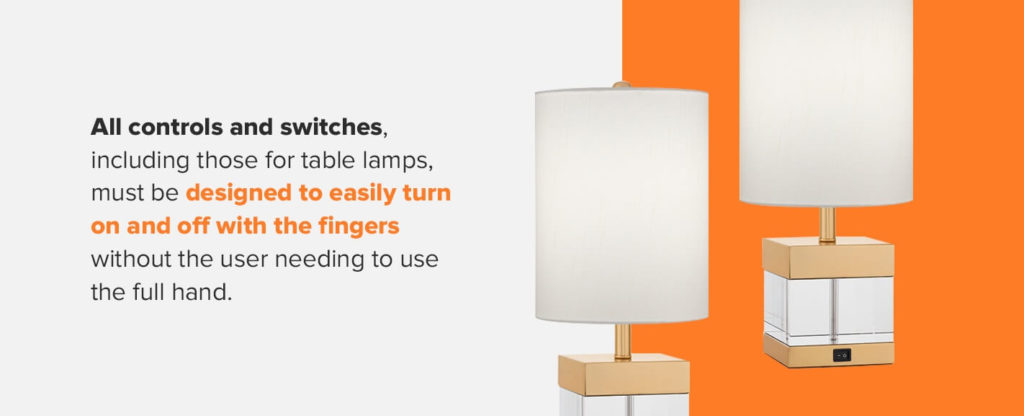
ADA Requirements for Table Lamps
The switches also need to be easy to reach, especially if there’s an obstruction between the guest and the lamp switch. For example, if a table lamp is sitting on a hotel room desk, the desk must have clear space underneath — similar to ADA-compliant light sconces — allowing a guest in a wheelchair to comfortably fit their knees and toes.
The guidelines require the space up to 9 inches from the floor to be toe space and up to 27 inches from the floor to be knee space. In addition, guest shouldn’t have to reach more than 25 inches to access the switch, which should be no higher than 44 inches off the ground.
Aside from being physically accessible, ADA-compliant table lamps must also adhere to guidelines regarding operation and control, which means control switches for lamps and overhead lighting must be accessible. All controls and switches, including those for table lamps, must be designed to easily turn on and off with the fingers without the user needing to use the full hand.
The ADA requires all controls to be able to be turned off and on with just one hand. The light also must not require the guest to twist their wrist to turn it on or off, and there should be no need for punching the switch or grasping it tightly. Ideally, a button-like light switch is the most effective, but flip switches are acceptable as well. Regardless of switch type, ADA guidelines also dictate that a person should not need more than five pounds of force to make the light function.
ADA Requirements for Reading Lamps
Similar to table lamps, for reading lamps to be considered ADA-compliant lighting, their switches need to be accessible to everyone. Whether the lamp is located on the floor or a bedside table, it needs to have at least 30 inches of space around it so that individuals in wheelchairs and other similar mobility devices have ample room to comfortably move around. There should be at least 60 inches of turning space between the bed and desk in a hotel room, and nothing should obstruct access to bathrooms, light switches and similar elements.
One useful thing about ADA standards is their allowance for side reaches. A person in a wheelchair or scooter should be able to access a light switch or lamp controls by reaching forward or sideways. Similar to the regulations for table lamps, side reaches need to be between 15 inches and 48 inches without obstruction.
If there is an obstruction, like a bedside table or dresser on which the reading lamp sits, the lamp switch should be no more than 46 inches from the ground, which requires the guest to reach only as far as 10 inches. If the obstruction is larger, like a desk, the maximum length a guest should need to reach is 25 inches, with the lamp switch located no higher than 46 inches from the ground.
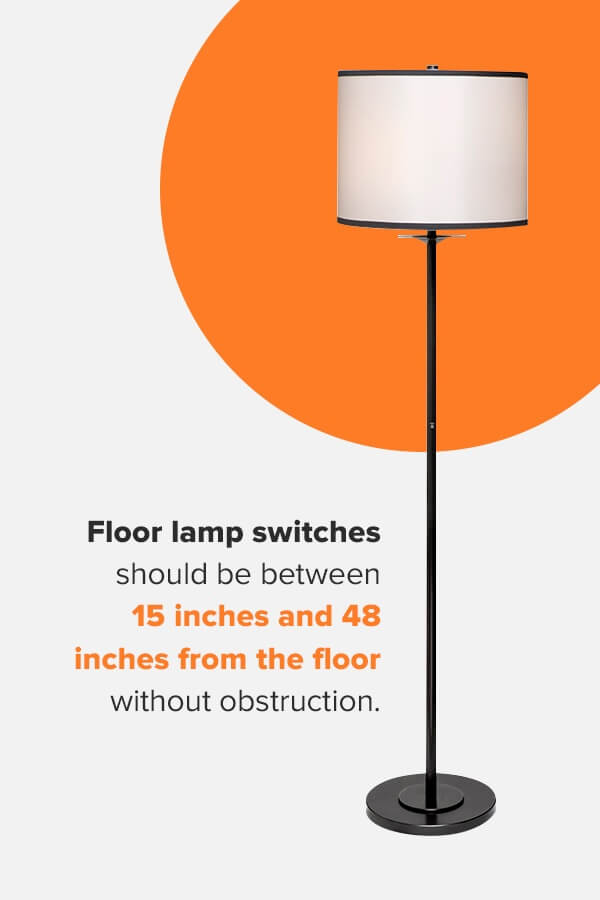
ADA Requirements for Floor Lamps
Like reading lamps, floor lamps can be as tall or short as you want, but the access point to turning them on and off must abide by ADA guidelines. As of March of 2012, the ADA updated its guidelines, changing the acceptable height for switches on floor lamps. It’s now the same as for other switches, making 48 inches above the floor the highest a floor lamp switch can be.
The switch location guidelines for floor lamps are very much like those for reading lamps and table lamps. Unlike the former two, which can often be obstructed, floor lamps are unlikely to face obstruction. Floor lamp switches should be between 15 inches and 48 inches from the floor without obstruction.
If for whatever reason there is an obstruction — like a one-seater couch, for example — the same rules apply regarding reach. The maximum height of the switch reduces to a maximum of 44 inches above the ground if there is an obstruction that requires a reach of more than 20 inches.
Floor lamps should be used wisely, especially in smaller spaces, since they’re not exempt from the ADA guidelines about turning room. Everyone — including people in wheelchairs and scooters — must have 60 inches of room in which to turn without bumping into anything and risking injury.
ADA Requirements for Ceiling Lighting
The placement of ceiling lighting allows for a lot more creativity and fun because there’s more freedom from ADA requirements. Chandeliers and pendant lights can be as large and ornate as you want and still be considered ADA-compliant ceiling lighting. This kind of lighting also allows for more freedom regarding the number of lights that can hang from a ceiling. Smaller hanging lights with multiple bulbs are just as acceptable as a singular, large ceiling light that can command a room.
The reason for this freedom is that 80 inches is the minimum head clearance according to the ADA. The head clearance exists to prevent guests from bumping their heads on lighting fixtures, which may lead to injuries like concussions or even burns. Spaces with low ceilings may not be able to take advantage of lower-hanging ceiling lighting if they risk extending past the head clearance space.
Public interiors, like restaurants and hotel rooms, rarely have ceilings low enough to make adhering to ADA guidelines a problem for ceiling lighting, encouraging creativity and brand personality even with lighting fixtures.
Contact Remington Lighting for More Information on ADA-Compliant Lighting
Whether you’re looking to upgrade existing lighting or seeking the perfect fixtures for a new project, Remington is here to lend an expert hand. Our extensive collection of lighting products is ADA-compliant as well as fully customizable, so you can be sure you’re getting exactly what you need without exceeding your budget.
Our team of experts is also able to provide design, logistical and manufacturing services, providing as much or as little assistance as you need from the drawing board right up to the final product. Our mission is to work collectively with interior designers and architects to make their visions reality. An enduring visual statement and achieving the project’s creative intent are just two of the things we aim to do for our clients — along with a focus on communication and personal service.
For more information about our interior lighting products, fill out our online contact form or call 717-737-7120.

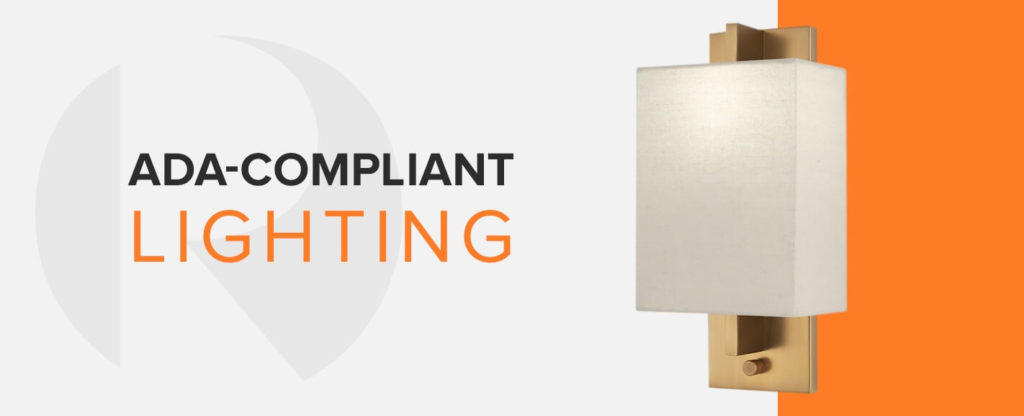
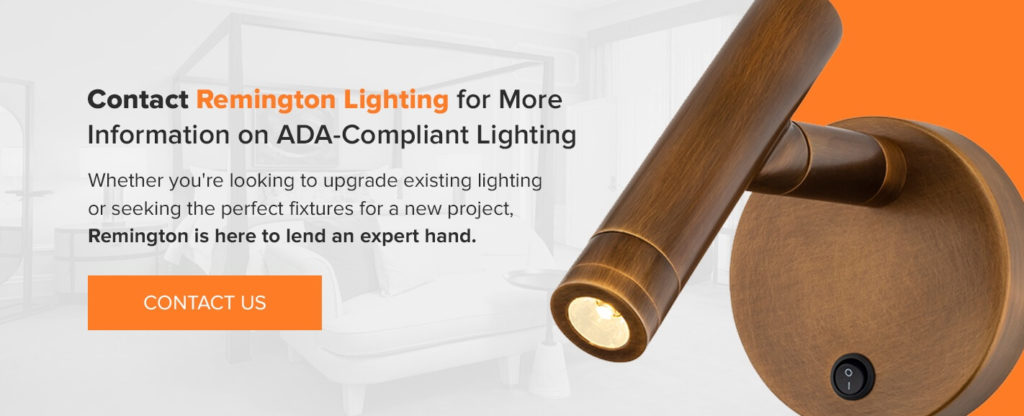
Leave a Reply